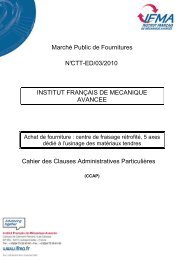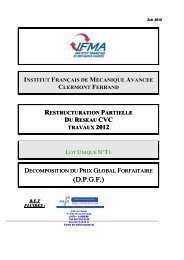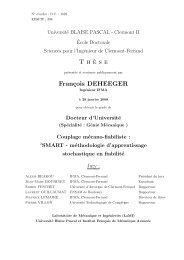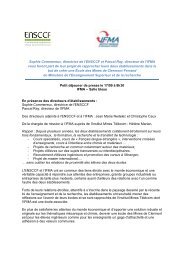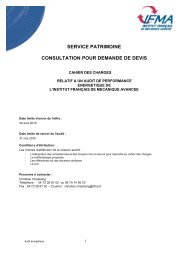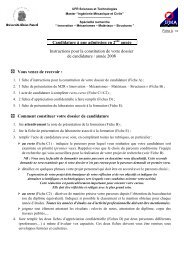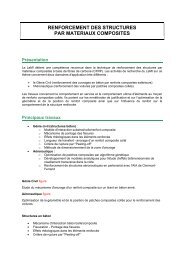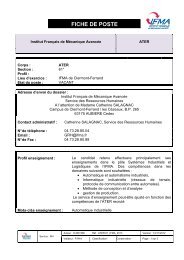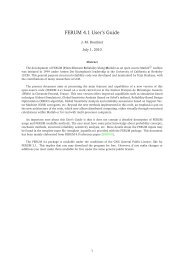FERUM 4.0 User's Guide - IFMA
FERUM 4.0 User's Guide - IFMA
FERUM 4.0 User's Guide - IFMA
- No tags were found...
You also want an ePaper? Increase the reach of your titles
YUMPU automatically turns print PDFs into web optimized ePapers that Google loves.
% Flag for computation of sensitivities w.r.t. means, standard deviations, parameters and% correlation coefficients% 1: all sensitivities assessed, 0: no sensitivities assessmentprobdata.flag_sens = 1;% Flag for computation of sensitivities w.r.t. thetag parameters of the limit-state function% 1: all sensitivities assessed, 0: no sensitivities assessmentgfundata(1).flag_sens = 1;analysisopt.ffdpara_thetag = 1000; % Parameter for computation of FFD estimates of dbeta_dthetag% perturbation = thetag/analysisopt.ffdpara_thetag if thetag ~= 0% or 1/analysisopt.ffdpara_thetag if thetag == 0% Recommended values: 1000 for basic limit-state functions% 100 for FE-based limit-state functions3.1.3 FORM with search for multiple design pointsSearch for multiple MPPs such as described in[DKD98] is also implemented in <strong>FERUM</strong> <strong>4.0</strong> (option 11). Figure2 illustrates the use of this method, applied to a 2D example with a parabolic limit-state function[DKD98]:g(x)= g(x 1 , x 2 )= b− x 2 −κ(x 1 − e) 2 (8)where b=5,κ=0.5 and e=0.1. Both variables x 1 and x 2 are independent and identically distributed (i.i.d.)standard normal random variables.This problem is characterized by two MPPs at similar distances from the origin and basic FORM algorithmresults are therefore not valid: 1.83·10 −3 instead of 3.02·10 −3 reference value for p f . Results in Figure2 are obtained with parameter values recommended in[DKD98], i.e.γ=1.1,δ=0.75 andε=0.5. Theseparameters are set in the form_multiple_dspts.m function. All valid MPP results obtained with <strong>FERUM</strong> <strong>4.0</strong> arestored in anALLformresults array which is added as an extra field to theanalysisopt structure variable.5U-space5U-space5U-spacex20x20x20-5-5 0 5x1-5-5 0 5x1Figure 2: FORM with search for multiple design points.-5-5 0 5x13.2 SORM curvature-fitting and point-fittingAs in the previous version, <strong>FERUM</strong> <strong>4.0</strong> offers two ways for computing a second-order approximation of thefailure probability. In both methods, the SORM approximation of the failure probability p f 2 is computed withBreitung or Tvedt formulae, as in <strong>FERUM</strong> 3.1.The first method consists in determining the principal curvatures and directions, by solving an eigenprobleminvolving the Hessian of the limit-state function (option 12 of <strong>FERUM</strong> <strong>4.0</strong>). The Hessian is computedby finite differences, the perturbations being set in the standard normal space. All calls to the limit-state functioncorresponding to perturbated points are potentially sent simultaneously, as being all independent fromeach other.The second method consists in approximating the limit-state function by a piece-wise paraboloid surface[DKLH87](option 13 of <strong>FERUM</strong> <strong>4.0</strong>). This approximate surface must be tangent to the limit-state atthe design point and coincides with the limit-state at two points on each axis selected on both sides of theorigin, see Figure 4. It is built iteratively, with a limited number of iterations and all calls to the limit-statefunction, at each iteration, are potentially sent simultaneously as well. This second approach is advantageousfor slightly-noisy limit-state functions (e.g. when a FE code is involved), for problem with a large number ofrandom variables or when the computation of curvatures turns out to be problematic.8



